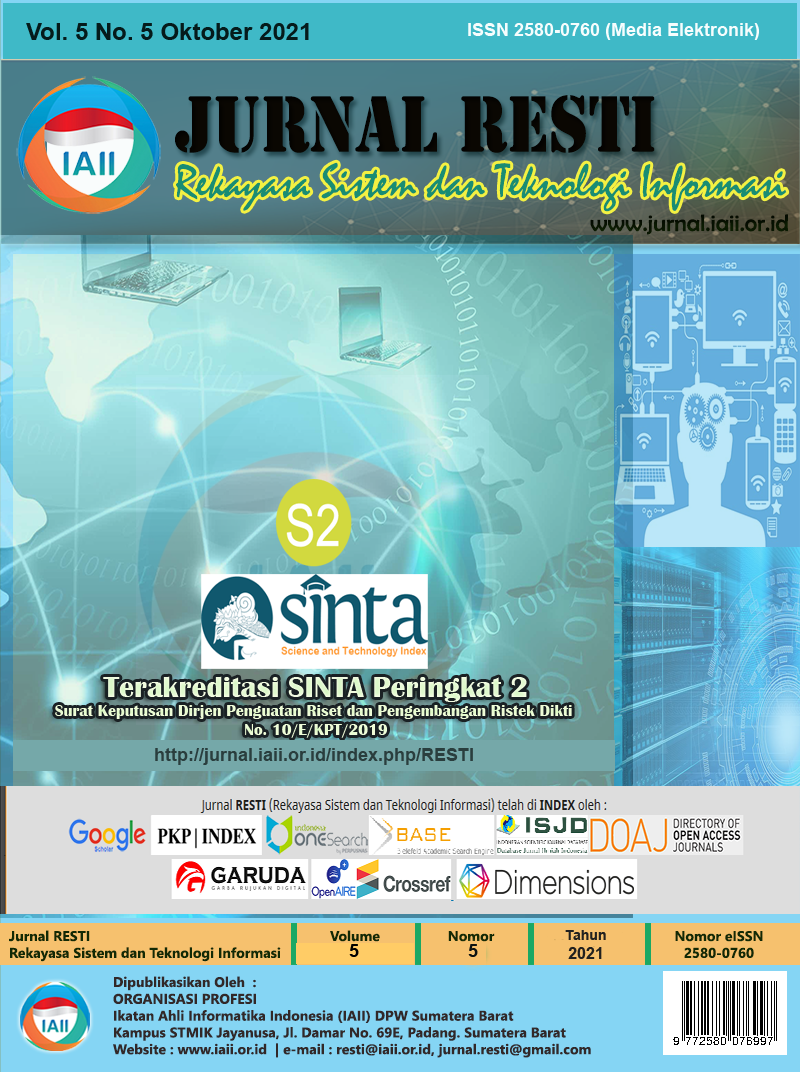Sentiment Analysis of Work from Home Activity using SVM with Randomized Search Optimization
Abstract
Government policy on a problematic topic can lead to pros and cons, including the implementation of work from home during the COVID-19 pandemic in Indonesia. Lots of social media users express their opinions through social media, such as Twitter. Using Twitter API, data on Twitter can be obtained freely, so it can be utilized for sentiment analysis. Therefore, this study contains an analysis of public sentiment on the work from home policy using various preprocessing methods and Support Vector Machine with randomized search optimization. The result shows that the use of the acronym expansion method, slang word translation, and emoji translation in the preprocessing stage can increase the F1 Score value. The best F1 score results obtained were 83.362%. The results of the preprocessing method are used to predict unlabeled data. Prediction results show that 62.35% of tweets have positive sentiments, on the contrary, 37.65% of tweets have negative sentiments. So, it can conclude that most netizens support the policy of work from home.
Downloads
References
B. Liu, Sentiment analysis and opinion mining. San Rafael: Morgan and Claypool, 2012.
V. I. Santoso, G. Virginia, and Y. Lukito, “Penerapan Sentiment Analysis pada Hasil Evaluasi Dosen dengan Metode Support Vector Machine,” Jurnal Transformatika, vol. 14, no. 2, p. 72, 2017.
H. C. Husada and A. S. Paramita, “Analisis Sentimen Pada Maskapai Penerbangan di Platform Twitter Menggunakan Algoritma Support Vector Machine (SVM),” Teknika, vol. 10, no. 1, pp. 18–26, 2021.
S. K. Lidya, O. S. Sitompul, and S. Efendi, Sentiment Analysis Pada Teks Bahasa Indonesia Menggunakan Support Vector Machine (SVM) Dan K-Nearest Neighbor (K-NN), Mar. 2015.
Z. Jianqiang and G. Xiaolin, “Comparison Research on Text Pre-processing Methods on Twitter Sentiment Analysis,” IEEE Access, vol. 5, pp. 2870–2879, 2017.
U. Widodo Wijayanto and R. Sarno, “An Experimental Study of Supervised Sentiment Analysis Using Gaussian Naïve Bayes,” 2018 International Seminar on Application for Technology of Information and Communication, 2018.
M. Ahmad, S. Aftab, M. Salman, N. Hameed, I. Ali, and Z. Nawaz, “SVM Optimization for Sentiment Analysis,” International Journal of Advanced Computer Science and Applications, vol. 9, no. 4, 2018.
J. Bergstra and Y. Bengio , “Random Search for Hyper-Parameter Optimization,” Journal of Machine Learning Research 13, pp. 281–305, Feb. 2012.
García, S., Luengo, J., & Herrera, F., “Data Preprocessing In Data Mining.” Cham, Switzerland: Springer International Publishing, 2015.
Ramaprakoso, “Analisis-Sentimen,” GitHub. [Online]. Available: https://github.com/ramaprakoso/analisis-sentimen/blob/master/ kamus/acronym.txt. [Accessed: 20-May-2021].
M. O. Ibrohim and I. Budi, “Multi-label Hate Speech and Abusive Language Detection in Indonesian Twitter,” Proceedings of the Third Workshop on Abusive Language Online, 2019.
W. Dai, “Improvement and Implementation of Feature Weighting Algorithm TF-IDF in Text Classification,” Proceedings of the 2018 International Conference on Network, Communication, Computer Engineering (NCCE 2018), 2018.
Y. Wang and H. Y. Youn, “Feature Weighting Based on Inter-Category and Intra-Category Strength for Twitter Sentiment Analysis,” Applied Sciences, vol. 9, no. 1, p. 92, 2018.
V. N. Vapnik, Statistical learning theory. New York: Wiley, 1998.
Rojas-Dominguez, L. C. Padierna, J. M. Carpio Valadez, H. J. Puga-Soberanes, and H. J. Fraire, “Optimal Hyper-Parameter Tuning of SVM Classifiers With Application to Medical Diagnosis,” IEEE Access, vol. 6, pp. 7164–7176, 2018.
Copyright (c) 2021 Jurnal RESTI (Rekayasa Sistem dan Teknologi Informasi)

This work is licensed under a Creative Commons Attribution 4.0 International License.
Copyright in each article belongs to the author
- The author acknowledges that the RESTI Journal (System Engineering and Information Technology) is the first publisher to publish with a license Creative Commons Attribution 4.0 International License.
- Authors can enter writing separately, arrange the non-exclusive distribution of manuscripts that have been published in this journal into other versions (eg sent to the author's institutional repository, publication in a book, etc.), by acknowledging that the manuscript has been published for the first time in the RESTI (Rekayasa Sistem dan Teknologi Informasi) journal ;








